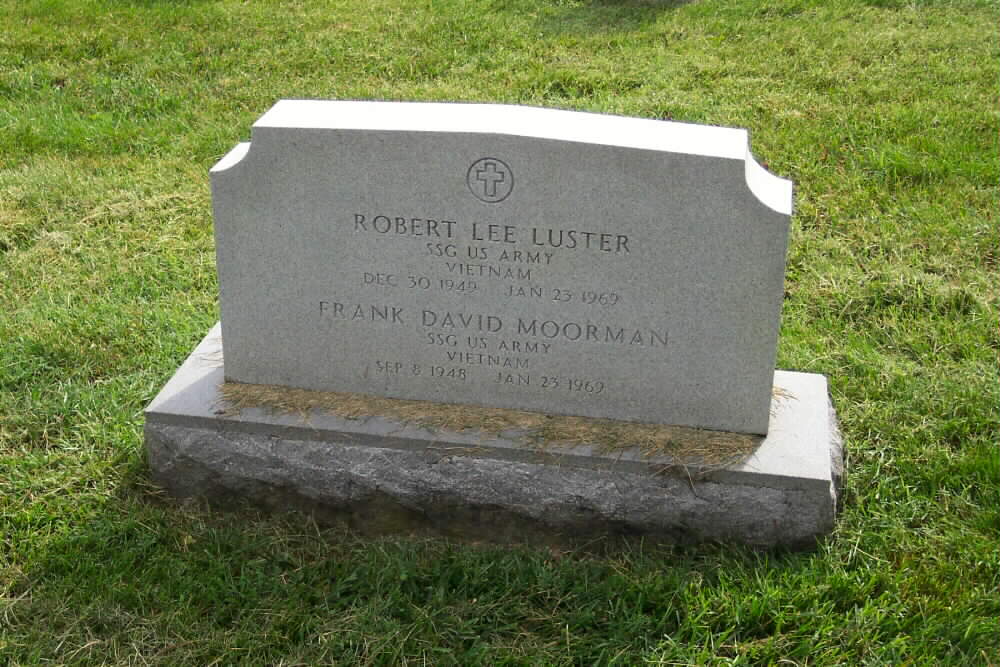Robert Lee Luster was born on December 30, 1949 and joined the Armed Forces while in Tiffin, Ohio.
He served in the United States Army, and attained the rank of Staff Sergeant.
Robert Lee Luster is listed as Missing in Action.
Subsequently returned home and buried in Section 46 of Arlington National Cemeery with Frank David Moorman.
LUSTER, ROBERT LEE
Remains Returned 27 January 1969, ID’d 23 February 1976
(Family does not accept ID)
Name: Robert Lee Luster
Rank/Branch: E3/US Army
Unit:
Date of Birth: 30 December 1949
Home City of Record: Tiffin Ohio
Date of Loss: 23 January 1969
Country of Loss: South Vietnam
Loss Coordinates: 141911N 1074330E (YA940681)
Status (in 1973): Missing in Action
Category: 3
Acft/Vehicle/Ground: UH1H
Refno: 1365
Other Personnel in Incident: William R. Henderson, Frank D. Moorman (both
missing); Robert F. Scherdin (missing – see text)
Source: Compiled by Homecoming II Project 01 April 1991 from one
or more of the following: raw data from U.S. Government agency sources,
correspondence with POW/MIA families, published sources, interviews.
Updated by the P.O.W. NETWORK 1998.
REMARKS: REMS REC 690127, IDD 760222
SYNOPSIS: MACV-SOG (Military Assistance Command, Vietnam Studies and
Observation Group) was a joint-service unconventional warfare task force
engaged in highly classified operations throughout Southeast Asia. The 5th
Special Forces channeled personnel into MACV-SOG (although it was not a
Special Forces group) through Special Operations Augmentation (SOA), which
provided their “cover” while under secret orders to MACV-SOG. The teams
performed deep penetration missions of strategic reconnaissance and interdiction into Laos and Cambodia which were called, depending on the time frame, “Shining Brass” or “Prairie Fire” missions.
On December 19, 1968, PFC Robert F. Scherdin was the assistant team leader
of a MACV-SOG reconnaissance patrol in Rotanokiri Province, Cambodia, near
the border of Laos, Cambodia and Vietnam. The team leader, suspecting enemy
activity, had taken four members of the team to check out the area. The rear element, with Scherdin in charge, came under heavy automatic weapon fire as
they were moving up to the leader’s position. Montagnard soldier Nguang in
this element, saw Scherdin fall on his right side and tried to help him stand up, but Scherdin only groaned and would not get up. Nguang was then wounded himself and realized that he had been left by the other three Vietnamese of the rear element, whereupon he left Scherdin and joined the rest of the unit.
The team leader and his element were extracted a short time later, then the rear element was extracted, except for Scherdin. The team leader had been informed that Scherdin had been wounded and because of the tactical situation, had to be left behind. Scherdin was not seen again.
On December 30, a platoon was inserted into the area to search for Scherdin, but had to be extracted because of heavy enemy activity. In January, 1969, the rear element of the original team was also reinserted and remained four days. They died in a helicopter crash shortly after their extraction. They had not been questioned by the investigation board, and it is not known if they located information concerning Scherdin.
There are only three Americans missing who are associated with the loss of a
helicopter in January 1969. Lost January 23, 1969, in the general vicinity of the Scherdin loss, they are SGT. William R. Henderson, SP4 Frank D. Moorman and PFC Robert L. Luster. These three were lost in the Tri-border area in South Vietnam. Their remains were recovered on January 27, 1969 and positive identifications confirmed February 23, 1976.
According to Luster’s wife, the remains were subsequently buried in a mass grave. She does not accept the identification of her husband. Further, Mrs. Luster states that one of the team “walked off the plane in 1973” (was a released POW). According to all available public records, only Luster, Moorman and Henderson were classified missing from this incident, and no released POW went missing that day.
Michael Robert Patterson was born in Arlington and is the son of a former officer of the US Army. So it was no wonder that sooner or later his interests drew him to American history and especially to American military history. Many of his articles can be found on renowned portals like the New York Times, Washingtonpost or Wikipedia.
Reviewed by: Michael Howard


